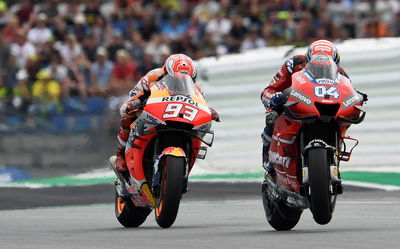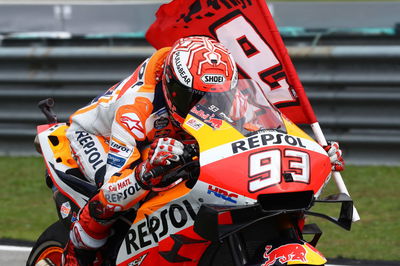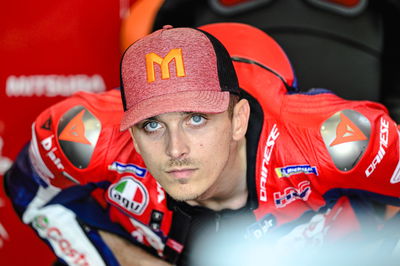Active aero: MotoGP to limit wing flex in 2020
As part of the expanding wing regulations for the 2020 MotoGP season, a new 'flex test' will be introduced to strengthen the ban on active aerodynamics.
The current technical regulations simply state 'moving aerodynamic devices are prohibited'.
This clearly prevents any obvious form of active aerodynamics, such as mechanical wing movement controlled by an external power supply. But nothing is perfectly rigid and, like a tree blowing in the wind, every part of a motorcycle moves or flexes to a certain degree when out on track.

As part of the expanding wing regulations for the 2020 MotoGP season, a new 'flex test' will be introduced to strengthen the ban on active aerodynamics.
The current technical regulations simply state 'moving aerodynamic devices are prohibited'.
This clearly prevents any obvious form of active aerodynamics, such as mechanical wing movement controlled by an external power supply. But nothing is perfectly rigid and, like a tree blowing in the wind, every part of a motorcycle moves or flexes to a certain degree when out on track.
Such 'aeroelasticity' of the bodywork can be exploited by crafting parts that deliberately flex more than necessary, or change shape in an advantageous way, depending on the speed of the motorcycle.
For example, since the main purpose of the wings is to reduce wheelies, a clever design would hold the wings at maximum downforce until the bike reaches a speed where wheelies are no longer a factor.
From that point on, the downforce created by the wings is not needed and they turn from being a benefit into a disadvantage, due to the drag they create hurting ultimate top speed.
Therefore if, when exposed to the greater load generated at higher speeds, parts of the wing 'pod' sections that hang off the bike were designed to bend into a slightly more streamlined position, drag would be lowered and top speed increase. So it's active but, if there are no specific flex limits, passes as accidental.
Such minor gains would probably have been dismissed in the past, but in an era where the top ten is often covered by less than one-second a lap, any advantage must now be considered.
Formula One has been grappling with the issue of deliberate aerodynamic flex for years, including rear wings that bend backwards at top speed and front wings that droop lower to the track. A similar solution to F1 will now make its way into the MotoGP technical rules: A load will be placed on parts of the bodywork to check the amount of movement.
"For next year, there will be a new rule [to limit flex] and we will make a proper test," said Ducati Corse general manager Gigi Dall’Igna, during a wide-ranging interview with Crash.net at Sepang to coincide with the extension of their technical partnership with Shell.
Dall’Igna didn't want to be drawn on whether some MotoGP manufacturers were suspected of taking advantage of the current 'flex' loophole.
"It's just to clarify the rules, which are probably not so clear at the moment. It was agreed by everybody," he said.
MotoGP technical director Danny Aldridge confirmed to Crash.net that the new test will 'limit the amount of flex permitted by the wings'.
The test will involve a force being applied from above and the resulting movement of the bodywork measured. Special equipment will be produced to carry out the new checks.
The flex test forms part of a beefed-up range of 2020 aerodynamic rules, which also includes more precise dimensions for the wing sections and introduction of Aero Body restrictions (one update per season) for all non-mechanical bodywork, including the infamous swingarm 'tyre cooler'.
Dall’Igna, whose design team pioneered the modern generation of wings, swingarm spoilers and wheel covers, is cautiously optimistic that the comprehensive new rule package will not require further amendments.
"I hope so, but every year we hear that from now on the rules will remain the same… and then they change!" he smiled.
Meanwhile, a recent announcement from the Grand Prix Commission revealed that in future teams will be able to remove wings from their bikes at Phillip Island, something that would currently mean breaking the Aero Body/Homologation rules (unless one of a rider's two fairings allowed for the season was already wingless).
The move implies that the wing sections are thought to have had an adverse effect on safety in the kind of extreme gusty crosswinds that forced the postponement of qualifying at last month's Australian MotoGP, after Miguel Oliveira was blown off the circuit heading into Turn One.












